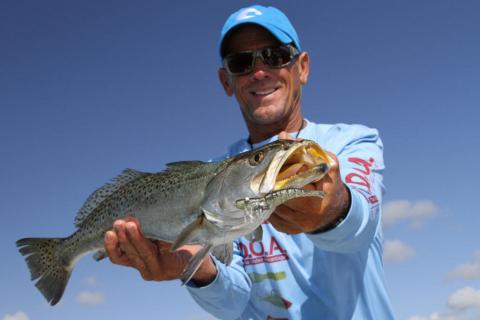
Folks throughout the Gulf states are well familiar with gators of the reptilian kind, but mentioning “gators” to coastal anglers fosters pleasant thoughts of hefty speckled trout also called sea trout. The basic design and paint job remains consistent with the smaller, barely legal trout, but big gator trout take on a cunning and ferocious nature meriting the allusion.

predators. photo by D. Brown
Indeed, trout reaching two feet or better typically solitary or small pack lifestyles, as opposed to the schooling nature of younger fish. Despite the softer body composition, this is one of the Gulf’s most aggressive predators. Equally accessible by boat, kayak or wading, big trout are cagey creatures, but they will fall for the right presentations.
Matching wits with these giants of freckled flanks may reward you with an Instagram-worthy moment, but consider that these fish have reached impressive proportions by being smart and using every natural factor in their favor. Whether or not you’re savvy enough to “outsmart” a big, wily trout is up to you, but the path to success is paved with diligent attention to those factors.
What is the Seasonality of Speckled Trout?
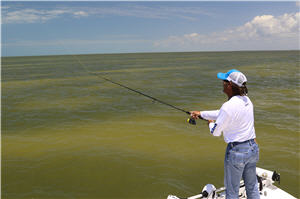
for depth variances on broad flats.
photo by D. Brown
Late-winter through spring sees larger concentrations of giant Gulf trout moving into coastal shallows for spawning, while the northern Gulf’s aggregations come a little later. In all regions, look for increased opportunity with large numbers of big trout feeding aggressively. Just remember that the largest trout are usually females, so carefully release them to ensure survival and successful spawns.
Along with the calendar reference, we find three key variables that play significant roles in determining where you may encounter giant trout. These truths apply to all, but like humans, the larger, older fish tend to be particularly sensitive — perhaps stubbornly set in their ways.
Salinity: While snook, tarpon, jacks and flounder can tolerate low to zero salinity, trout of all sizes generally prefer saltier water. That means winter-spring rains will lower salinity levels around rivers and outflows. Louisiana anglers see major impacts when the Mississippi River rises, as the increased freshwater influx pushes trout out deeper.
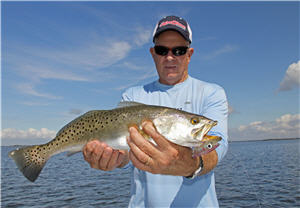
trout. photo by D. Brown
Clarity: High rivers also influence turbidity and trout simply will not tolerate muddy water. A hungry predator may briefly enter stained areas to feed, but the higher the clarity, the happier the trout.
Worth Noting: Because saltwater is heavier than fresh, you’ll often find a layer of cleaner Gulf brine beneath the upper layer of river water. When depth allows enough space for a significant lower layer, don’t hesitate to fish through the less desirable water to reach the big trout that may be lurking below.
Temperature: The cooler to moderate temperatures of the year’s first two quarters offers comfortable conditions for big trout, but summer’s swelter will drive them out of the shallows. That being said, it’s not uncommon to find beastly trout hunting whisper-thin depths right at daybreak. Finger mullet and other forage fish running the edges of barrier islands, break walls and other hard lines are prime targets for big speckled trout, so stay sharp and approach shallow feeding zones with supreme stealth.
Big Trout go With the Flow
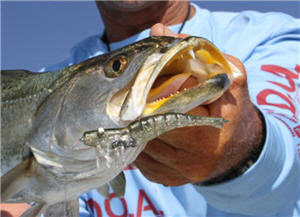
effective lures for trout. photo by D. Brown
Coastal predators generally feed best when the water’s moving, but big trout get big by employing an energy conservation strategy — they like the path of least resistance. So, while all those little trout are keen to zip in and out of a racing current, your big gator trout are going to do most of their work during the first and last hour of a tide cycle, when they don’t have to fight the full force of the water.
Pay attention, however, to bait balls — tight groups of sardines, threadfin herring, or glass minnows — gathered by a swift tide. Such concentrations of food may tempt big trout, so it’s usually worth exploring a flock of terns or gulls hovering and screeching over the surface — a clear sign that predators are pushing the baitfish topside.

your trout lures. photo by D. Brown
Also, consider that low tides allow shallow rocks and oyster bars to absorb the sun’s heat and then radiate that warmth like a heating blanket with the incoming cycle covers the area. You may pick up the occasional big trout during low tide, but increased depth plus a cozy heating source equals maximum attraction.
Finding the Sea Trout Habitat
Drifting vast sea grass flats or barrier island surf zones will often turn up plenty of keeper trout, but when you run into a legitimate gator, it’s almost always because you came across a key feature that suits their ambush feeding strategy. That could be an isolated rock pile, a submerged oyster reef or simply a deeper area on a broad flat.

The latter scenario is often the key ingredient, as big trout love to lay in small troughs, potholes and cuts where they can wait for meals to pass overhead. Finding these subtle sweet spots can feel like the proverbial needle-in-a-haystack search, so pick a line, fish across the flat, move over a cast length, fish across the area again and repeat until you pick up a few big bites. From there, you can usually find big trout in similar depths throughout the flat.
Knowing the Gator Trout Strategy & What They Like

Suspending Twitchbait
Minimum output for maximum input — knowing this gator trout strategy helps anglers wisely select their offerings. Hanging jumbo shrimp, sardines, pinfish, pigfish, or croakers beneath a float keeps these big meals visible and vulnerable; but use circle or kahle hooks, like the Trokar Saltwater Circle Inline or Saltwater Kahle hook, which prevent gut hooking and facilitate safe release.
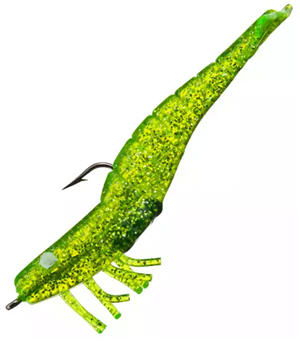
On the artificial side, big trout will absolutely blast topwater walking baits like the Bass Pro Shops XTS Lures Pencil Plug, Heddon Saltwater Super Spook or Rapala Skitterwalk. The big-bait-big-fish mantra is definitely true, but if the fish are playing hard to get, downsizing to a Heddon Super Spook Jr. or a MirrOlure MirrOMullet often does the trick. Whatever your choice, avoid startling shallow gators by feathering your cast for a softer entry, or bombing the bait well past your target zone and working it into range.
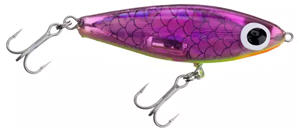
Another proven trout getter, slow sinking twitchbaits like MirrOlure’s MirrOdine, the LIVETARGET Scaled Sardine, or Paul Brown’s Soft-Dine suspending twitchbait work well over deep grass, potholes and troughs. You’ll also tempt your targets with synthetic shrimp like the original D.O.A. Shrimp lure, Egret Vudu Shrimp or Savage Gear TPE 3D Manic shrimp. Free lining on jig heads or weighted wide gap hooks works, but for maximum attention, work a shrimp lure under a popping cork — rig your own or use the prerigged Offshore Angler Knockout Combo.
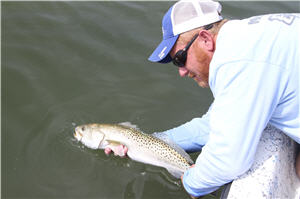
photo by D. Brown
Trout that reach “gator” proportions strike hard and fight with an impressive ferocity exceeding their relatively soft form. Enjoy the moment, but be aware of local regulations on size/bag limits and carefully release the ones you’re not keeping.
Tip: Note Florida’s current closure here
- 3072 views

